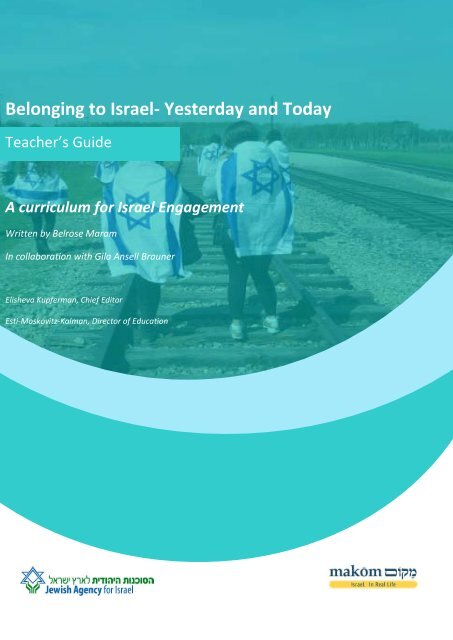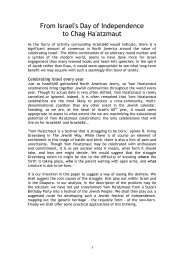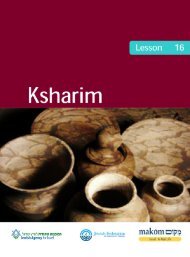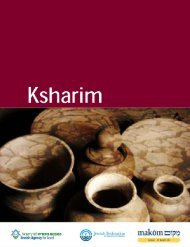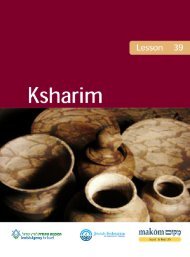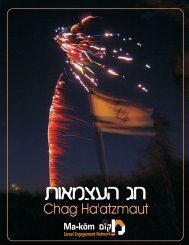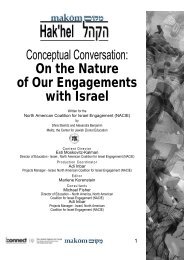Belonging to Israel- Yesterday and Today - Makom
Belonging to Israel- Yesterday and Today - Makom
Belonging to Israel- Yesterday and Today - Makom
Create successful ePaper yourself
Turn your PDF publications into a flip-book with our unique Google optimized e-Paper software.
Introduction<br />
Teacher’s Guide<br />
<strong>Belonging</strong> <strong>to</strong> <strong>Israel</strong>- <strong>Yesterday</strong> <strong>and</strong> <strong>Today</strong><br />
Teacher’s Guide<br />
A curriculum for <strong>Israel</strong> Engagement<br />
Written by Belrose Maram<br />
In collaboration with Gila Ansell Brauner<br />
Elisheva Kupferman, Chief Edi<strong>to</strong>r<br />
Esti-Moskovitz-Kalman, Direc<strong>to</strong>r of Education<br />
1
Introduction<br />
Teacher’s Guide<br />
Introduction<br />
The overarching goal of the curriculum below is <strong>to</strong> deepen engagement with<br />
<strong>Israel</strong> among the participating students. As such, the rationale behind the<br />
work is that by imbuing knowledge <strong>and</strong> thinking strategies, <strong>and</strong> creating<br />
experiences that elicit emotions <strong>and</strong> attitudes, the students will come <strong>to</strong> gain<br />
a meaningful underst<strong>and</strong>ing of the place of <strong>Israel</strong> in Jewish life. We believe<br />
that if you combine this meaningful underst<strong>and</strong>ing with a personally<br />
implicated worldview of their role in <strong>Israel</strong> engagement (both in the present<br />
as well as the future), the deepened <strong>Israel</strong> engagement we set out <strong>to</strong> achieve<br />
will be attainable.<br />
Target Population<br />
The present program was designed with North American Junior High School<br />
students (grades 6-8) in mind. The curriculum cab be used at either Day Schools<br />
or Hebrew Schools.<br />
Curriculum Structure<br />
The curriculum combines both formal classroom lessons <strong>to</strong> be guided by the<br />
teacher, as well as a strong emphasis on independent study.<br />
The Fundamental Ideas<br />
Jewish educa<strong>to</strong>rs in the United States are challenged with the task of creating a<br />
meaningful learning process that will serve <strong>to</strong> strengthen the Jewish identities of<br />
their students. It is our belief that a deep connection <strong>to</strong> <strong>Israel</strong> plays an<br />
important role in the development of the student's Jewish identity. It is<br />
important <strong>to</strong> emphasize that this kind of connection <strong>to</strong> <strong>Israel</strong> can only be<br />
created if students are able <strong>to</strong> deeply underst<strong>and</strong> the content they are being<br />
taught. In other words, the knowledge they acquire needs <strong>to</strong> be applicable <strong>and</strong><br />
relevant <strong>to</strong> their own lives.<br />
The "<strong>Belonging</strong> <strong>to</strong> <strong>Israel</strong>- <strong>Yesterday</strong> <strong>and</strong> <strong>Today</strong>" curriculum encourages students<br />
<strong>to</strong> think for themselves, <strong>and</strong> come <strong>to</strong> their own conclusions about the<br />
connection of the Jewish People <strong>to</strong> the L<strong>and</strong> of <strong>Israel</strong>, using examples from the<br />
past <strong>and</strong> comparing them with examples from the present.<br />
The students will begin a his<strong>to</strong>rical <strong>and</strong> geographical journey in underst<strong>and</strong>ing<br />
how <strong>Israel</strong> has developed in the past 60+ years. They will search different<br />
periods <strong>and</strong> places, while confronting the dilemmas of the people from those<br />
times. They will also have <strong>to</strong> confront real-life, contemporary dilemmas <strong>and</strong> find<br />
creative solutions that will require them <strong>to</strong> work in partnership with young Jews<br />
like themselves in <strong>Israel</strong>.<br />
2
Introduction<br />
Teacher’s Guide<br />
The General Goals of the curriculum are<br />
Affective<br />
• To develop an awareness of the centrality of <strong>Israel</strong> <strong>to</strong> the Jewish people.<br />
• To develop a feeling of belonging <strong>to</strong>ward <strong>Israel</strong>.<br />
• To promote the involvement of the students in <strong>Israel</strong>i society.<br />
• To develop a desire <strong>to</strong> learn <strong>and</strong> work <strong>to</strong>gether with <strong>Israel</strong>i youth.<br />
Cognitive<br />
• To deepen the students' knowledge about the roots of the connection between<br />
the Jewish people <strong>and</strong> the L<strong>and</strong> of <strong>Israel</strong>.<br />
• To underst<strong>and</strong> <strong>Israel</strong> as the home of the Jewish people. (Every Jew has a right <strong>to</strong><br />
choose <strong>to</strong> live there <strong>and</strong> become an <strong>Israel</strong>i citizen).<br />
• To see <strong>Israel</strong> as the fulfillment of the prayers <strong>and</strong> dreams of generations of Jews.<br />
• To underst<strong>and</strong> how the geographical uniqueness of the L<strong>and</strong> of <strong>Israel</strong> has<br />
influenced the lives of the <strong>Israel</strong>is how through the past 60+ years.<br />
• To underst<strong>and</strong> how the different aspects of <strong>Israel</strong>i lived there over society have<br />
developed over the last 60+ years.<br />
• To underst<strong>and</strong> how Jewish artists have expressed their connection <strong>to</strong> the L<strong>and</strong><br />
of <strong>Israel</strong> over the last 60+ years.<br />
The Learning Skills the program seeks <strong>to</strong> enhance<br />
1. Students will have discussions that are based on real-life Jewish/<strong>Israel</strong>i<br />
dilemmas; realizing that the Jewish people have different points of view,<br />
<strong>and</strong> different ways of thinking.<br />
2. Students will explore his<strong>to</strong>rical events using a variety of mediums <strong>and</strong><br />
critical thinking strategies, such as analyzing maps, documents, pictures, etc.<br />
3. Students will see their knowledge come <strong>to</strong> life, as the curriculum<br />
encourages them <strong>to</strong> apply the content <strong>to</strong> their own lives.<br />
4. Students will be able <strong>to</strong> express <strong>and</strong> present their own ideas through a<br />
variety of avenues, including problems solving, written reports, discussions,<br />
etc.<br />
3
Introduction<br />
Teacher’s Guide<br />
Methodolgy<br />
A. Central Spectrum<br />
The curriculum is based on the central spectrum: "<strong>Belonging</strong> <strong>and</strong> Longing for<br />
<strong>Israel</strong>: past, present, <strong>and</strong> future”. The students will come <strong>to</strong> underst<strong>and</strong> how the<br />
Jewish people have been connected <strong>to</strong> <strong>Israel</strong> from the time of the Bible until<br />
<strong>to</strong>day, <strong>and</strong> how this deep connection has helped in the development of the<br />
State of <strong>Israel</strong> over the last century. The students will underst<strong>and</strong> that the<br />
feeling of belonging <strong>to</strong>ward <strong>Israel</strong> is experienced in correlation with meaningful<br />
actions that individual Jews do relating <strong>to</strong> <strong>Israel</strong> (whether living in <strong>Israel</strong> or in the<br />
Diaspora). These important actions help the Jewish people be involved <strong>and</strong><br />
develop the feeling of belonging <strong>to</strong>ward <strong>Israel</strong>.<br />
B. Structure<br />
The curriculum consists of 4 distinct units:<br />
Unit 1:<br />
Bedrock <strong>and</strong> Foundation, in which the students will explore the various<br />
his<strong>to</strong>rical connections <strong>to</strong> the L<strong>and</strong> of <strong>Israel</strong>, with a focus on the Bible <strong>and</strong> Herzl.<br />
Unit 2:<br />
Rise <strong>and</strong> Walk the L<strong>and</strong>, in which the students will study the geography of <strong>Israel</strong><br />
over time, <strong>and</strong> learn about the early <strong>Israel</strong>i kibbutzim, as well as the main cities<br />
in modern <strong>Israel</strong>.<br />
Unit 3:<br />
Toward a Better World, in which the students will learn about the fabric of<br />
<strong>Israel</strong>i society, as well as some of the pressing social issues that affect it.<br />
Unit 4:<br />
Songs of <strong>Belonging</strong>: Jewish/<strong>Israel</strong>i Songs, in which students will study both<br />
classical <strong>and</strong> contemporary poetry/music that uses art <strong>to</strong> express connection <strong>to</strong><br />
<strong>Israel</strong>.<br />
The duration of each lesson is approximately 90 minutes. The teachers can<br />
decide how they want <strong>to</strong> manage the time <strong>and</strong> content of each lesson, <strong>and</strong> are<br />
free <strong>to</strong> change the content or activities as they see fit.<br />
4
Introduction<br />
Teacher’s Guide<br />
C. <strong>Israel</strong> Contest:<br />
At the completion of the units is the <strong>Israel</strong> Contest, an event we recommend<br />
showcasing as part of your school’s or community’s Yom Ha’atzmaut<br />
celebrations. The contests gives the students the opportunity <strong>to</strong> showcase their<br />
accumulated knowledge <strong>and</strong> connection <strong>to</strong> <strong>Israel</strong>. Some suggested questions for<br />
the contest are presented after the last unit in this curriculum.<br />
Assignments <strong>and</strong> Projects<br />
In each unit of the curriculum, students will be asked <strong>to</strong> submit a homework<br />
assignment. At the end of the curriculum they will get <strong>to</strong> showcase their<br />
projects in an “<strong>Israel</strong> Fair”. One of the most important homework assignments<br />
is the one for Unit 3, in which the students are asked <strong>to</strong> write a proposal for a<br />
solution <strong>to</strong> a real-life social problem in <strong>Israel</strong>. We recommend that the winner of<br />
the competition be given the opportunity <strong>to</strong> implement their solution on the<br />
ground.<br />
It is important <strong>to</strong> emphasize that teachers are encouraged <strong>to</strong> change or adjust<br />
the assignments. We underst<strong>and</strong> that each student <strong>and</strong> school has unique<br />
needs <strong>and</strong> goals. The content we’ve provided is merely a recommended format.<br />
The <strong>Israel</strong> Contest (Yom Ha’atzmaut Event)<br />
We recommend working the curriculum <strong>to</strong>wards Yom Ha’atzmaut, <strong>and</strong> holding<br />
the contest on Yom Ha’atzmaut. The teacher should select about 10 students <strong>to</strong><br />
be the contestants in the event. The students chosen <strong>to</strong> compete should be<br />
those that worked seriously throughout the curriculum <strong>and</strong> submitted <strong>to</strong>p<br />
quality assignments consistently.<br />
At the beginning of the contest all the students will be presenting their<br />
assignments in an “<strong>Israel</strong> Fair”. During the main contest event, the <strong>to</strong>p/winning<br />
assignments are going <strong>to</strong> be presented, one for each unit covered in the<br />
curriculum.<br />
1. Plays/skits with Herzl <strong>and</strong> the Biblical characters<br />
2. Advertisements <strong>to</strong> come <strong>to</strong> the <strong>Israel</strong>i city of choice<br />
3. Proposals for how <strong>to</strong> solve a problem in <strong>Israel</strong>i Society<br />
4. An artistic interpretation/adaptation of a selected poem<br />
5
Introduction<br />
Teacher’s Guide<br />
In between each presentation, the <strong>to</strong>p 10 students will be asked trivia questions<br />
about <strong>Israel</strong>, based on the body of information studied throughout the course of<br />
all four units.<br />
The winner of the contest is determined by the student who received the<br />
highest combined score for: points earned for correct answers during the<br />
quizzes <strong>and</strong> <strong>to</strong>p ranking scores for assignments presented.<br />
Suggested Prize: The student will travel <strong>to</strong> <strong>Israel</strong> <strong>to</strong> put in<strong>to</strong> effect their<br />
proposal for addressing their social problem in <strong>Israel</strong> (based on Unit 3).<br />
6
Introduction<br />
Teacher’s Guide<br />
Table of Contents:<br />
Book 1: Teacher’s Guide<br />
Book 2: Student Workbook<br />
Introduction<br />
Introduction<br />
Unit 1: Bedrock <strong>and</strong> Foundation<br />
Lesson 1: People <strong>and</strong> L<strong>and</strong><br />
Lesson 2: Creating the State<br />
…………..3<br />
……….13<br />
Unit 1: Bedrock <strong>and</strong> Foundation<br />
Lesson 1: People <strong>and</strong> L<strong>and</strong><br />
Lesson 2: Creating the State<br />
…………..2<br />
…………..9<br />
Unit 2: Rise <strong>and</strong> Walk the L<strong>and</strong><br />
Lesson 1: Geography<br />
Lesson 2: Kibbutz<br />
Lesson 3: Cities<br />
……………3<br />
…………...8<br />
………..14<br />
Unit 2: Rise <strong>and</strong> Walk the L<strong>and</strong><br />
Lesson 1: Geography<br />
Lesson 2: Kibbutz<br />
Lesson 3: Cities<br />
…………..1<br />
…………..9<br />
…………..18<br />
Unit 3: Toward a Better World<br />
Lesson 1: <strong>Israel</strong>i Society …………..3<br />
Lesson 2: Social Development ………..6<br />
Unit 3: Toward a Better World<br />
Lesson 1: <strong>Israel</strong>i Society …………..2<br />
Lesson 2: Social Development …………..5<br />
Unit 4: Songs of <strong>Belonging</strong><br />
Lesson 1: Classical<br />
Lesson 2: Modern<br />
<strong>Israel</strong> Contest<br />
…………..3<br />
………..11<br />
Unit 4: Songs of <strong>Belonging</strong><br />
Lesson 1: Classical<br />
Lesson 2: Modern<br />
…………..2<br />
…………..10<br />
7
Introduction<br />
Teacher’s Guide<br />
<strong>Belonging</strong> <strong>to</strong> <strong>Israel</strong>‐ <strong>Yesterday</strong> <strong>and</strong> <strong>Today</strong><br />
A curriculum for <strong>Israel</strong> Engagement<br />
Written by Belrose Maram<br />
In collaboration with Gila Ansell Brauner<br />
Esti‐Moskovitz‐Kalman, Direc<strong>to</strong>r of Education<br />
The <strong>Belonging</strong> <strong>to</strong> <strong>Israel</strong> curriculum presents an innovative approach <strong>to</strong> the traditional "<strong>Israel</strong><br />
Chiddon", or <strong>Israel</strong> quiz. Whereas former models emphasized memorization <strong>and</strong> accumulated<br />
knowledge, educa<strong>to</strong>rs <strong>to</strong>day recognize that the learner is not impacted by rote memorization<br />
in a world where the same information is accessible with the simple click of a but<strong>to</strong>n. This<br />
curriculum is about connection; engaging the learner by promoting belonging <strong>to</strong>, <strong>and</strong><br />
relationship‐building with, the L<strong>and</strong> of <strong>Israel</strong>.<br />
The curriculum combines both formal classroom lessons <strong>to</strong> be guided by the teacher, as well<br />
as a strong emphasis on independent learning. The curriculum consists of 4 distinct units:<br />
1. Bedrock <strong>and</strong> Foundation, in which the students will explore the various his<strong>to</strong>rical<br />
connections <strong>to</strong> the L<strong>and</strong> of <strong>Israel</strong>, with a focus on the Bible <strong>and</strong> Herzl.<br />
2. Rise <strong>and</strong> Walk the L<strong>and</strong>, in which the students will study the geography of <strong>Israel</strong> over<br />
time, <strong>and</strong> learn about the early <strong>Israel</strong>i kibbutzim, as well as the main cities in modern<br />
<strong>Israel</strong>.<br />
3. Toward a Better World, in which the students will learn about the fabric of <strong>Israel</strong>i<br />
society, as well as some of the pressing social issues that affect it.<br />
4. Songs of <strong>Belonging</strong>: Jewish/<strong>Israel</strong>i Songs, in which students will study both classical<br />
<strong>and</strong> contemporary poetry/music that uses art <strong>to</strong> express connection <strong>to</strong> <strong>Israel</strong>.<br />
<strong>Israel</strong> Contest: At the completion of the units is the culminating <strong>Israel</strong> Contest, a gr<strong>and</strong> event<br />
which we recommend showcasing as part of your school or community’s Yom Ha’atzmaut<br />
celebrations.<br />
The theory behind this curriculum is founded in big ideas about Jewish peoplehood <strong>and</strong> <strong>Israel</strong><br />
engagement, <strong>and</strong> was written with a h<strong>and</strong> on the pulse of contemporary educational theory<br />
on critical thinking. As such, the <strong>Makom</strong> educational team is currently in the process of<br />
revamping the question‐asking across the entire curriculum <strong>to</strong> reflect the wisdom <strong>and</strong> insight<br />
of the critical questioning theory, <strong>and</strong> bring the curriculum <strong>to</strong> the highest educational<br />
st<strong>and</strong>ards.<br />
We would like <strong>to</strong> express our heartfelt thanks <strong>to</strong> Belie for the hours of work, <strong>and</strong> tireless<br />
commitment <strong>to</strong> bringing genuine <strong>Israel</strong> engagement <strong>to</strong> Jewish students worldwide.<br />
Additionally, many thanks <strong>to</strong> Gila, for her patience <strong>and</strong> perseverance through the sifting <strong>and</strong><br />
sorting countless texts <strong>and</strong> educational materials. Thanks also <strong>to</strong> Elisheva, for her commitment<br />
<strong>to</strong> a quality finished product ‐ thanks for her hours of editing <strong>and</strong> re‐editing.<br />
Please enjoy this draft of the curriculum, <strong>and</strong> let us know how it goes!<br />
Sincerely,<br />
Esti Moskovitz‐Kalman<br />
Education Direc<strong>to</strong>r ‐ Makōm


